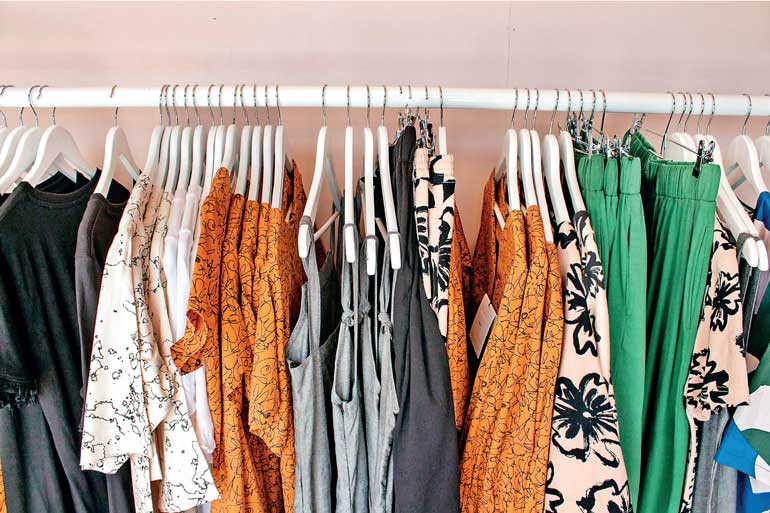Thursday Dec 12, 2024
Thursday Dec 12, 2024
Saturday, 3 July 2021 00:31 - - {{hitsCtrl.values.hits}}

Sri Lanka’s fashion sector is a growing industry that provides great value to the country and can serve as one of the engines of sustainable development

Vositha Wijenayake

Fouzul Hameed

Draupadie Weeraperuma

Alifiya Mutaher

The global production of clothes has increased drastically over recent decades, even in relation to the growing world population. Garment production has more than doubled between 2000 and 2014 alone, largely due to the rise of “fast fashion” and the fashion industry. While this has led to growth, increased revenues, and more employment opportunities, it has also greatly increased the sector’s emissions, environmental impacts, and waste.
The fashion industry with its various supply chains is one of the largest contributors to climate change. A 2021 report by the World Economic Forum identifies the fashion supply chain as the third largest global emitter that is responsible for about 5% of all greenhouse gas emissions. This includes different stages of garment or textile production from raw materials to manufacturing, packaging, and transport as well as different scales and levels from small-scale producers to large factories.
The largest part of the sector’s emissions comes from its raw materials, namely the production of fibres. Synthetic fibres such as polyester and nylon are derived from fossil fuels while cotton requires large amounts of water and is often cultivated with carbon-intensive fertilisers.
|
Lonali Rodrigo
|
However, fashion might not be the first, second, or third industry that comes to mind when we think of climate change. Lonali Rodrigo, Founder of Sri Lankan fashion brand House of Lonali, highlights this awareness gap: “I would say most people do not connect buying garments with climate change. They do not know that fashion is one of the largest polluters in the world. To make a difference, we need to choose climate-friendly clothing.”
In Sri Lanka, the fashion and apparel industry is a key economic sector that contributes nearly 7% of total GDP and provides direct and indirect livelihoods for more than 600,000 people, the majority of which are women. Particularly for poor and rural communities, the sector plays a key role in providing opportunities for economic diversification and income generation. Sri Lankan companies supply leading global brands and export to countries such as the US, UK, Italy, Germany, and Belgium.
To create greater awareness and reduce the environmental and social impacts of the sector, global trends and initiatives have begun to focus on many sustainable and climate-friendly choices. These include sustainable fashion, slow fashion, eco-friendly fashion, carbon-neutral fashion, ethical fashion, conscious fashion, fair trade fashion, circular fashion, closed-loop fashion, upcycled fashion, zero waste fashion, recycled, thrift, or second-hand fashion, cruelty-free fashion, or organic fashion.
“Consumption connects to climate change,” says Alifiya Mutaher, Founder of Colombo Design Market and Co-Founder of Local Forecast, an online store for artists and designers. “If we buy from small, sustainable brands, we reduce the amount of waste that is created in the production. If we look at the supply chain, it is really about reducing the number of resources that are going into the production. This also reduces carbon emissions and carbon footprints.”
At present, there is a growing number of companies and entrepreneurs in Sri Lanka who are turning towards ethical manufacturing, quality products, emission reduction, and improved production processes. Sri Lankan companies work with their international partners to reduce waste, increase production efficiency, and use renewable energy such as rooftop solar or biomass boilers.
“I think awareness is slowly growing,” says Draupadie Weeraperuma, Founder of majä – a new story, a lifestyle brand that upcycles and reuses pre-worn sarees. “Small businesses have growing awareness of the environment and how they can tread lightly on the planet. Action is being taken even by the larger organisations to find ways to be a bit more concerned about their footprint.” Fouzul Hameed, Managing Director of the Hameedias Group, one of Sri Lanka’s largest fashion companies, supports this: “When it comes to energy, we use more solar power, we have been reducing waste, we are reducing emissions.”
There is great potential to reduce emissions, waste, and pollution throughout the supply chain and manufacturing process. In many cases, a move towards sustainability and climate-friendliness not only benefits the environment but also provides a unique selling point that can align with traditional practices and natural resources, as long as they are sourced in a sustainable, ethical, and non-exploitative manner.
Mutaher explains one of these aspects: “Sri Lanka has great potential in terms of materials. If you look at the traditional materials we are using, all of them are sustainable. Even in terms of the dye, it is extracted from plants, flowers, and vegetables through sustainable processes. By encouraging the use of these traditional materials, we can make products that are a lot more sustainable and reflect Sri Lankan creative culture at the same time.”
A similar point is highlighted by Hameed: “Millions of gallons of chemicals are used in the fashion industry around the world. Here in Sri Lanka, we use tea to dye material, which is an organic and user-friendly dye that does not harm your skin. It is a bit costly to manufacture, but it is unique, very natural, and climate-friendly.”
While a transition is necessary and provides economic and ecological benefits, it is crucial to also keep the social dimension in mind. The fashion industry is not merely about designing and creating clothing, it is an important source of livelihoods, poverty alleviation, and sustainable development for hundreds of thousands of Sri Lankans. Any transition toward carbon neutrality, reduced environmental footprints, increased manufacturing efficiency, and reduced wastage needs to look at workers as well as consumers.
Therefore, when it comes to the transition of the fashion industry, it should be a just and equitable transition that leaves no one behind. The costs of transformation from fast fashion to sustainable fashion should not be borne by the poor and most vulnerable members of society but rather be considered a collective responsibility and commitment towards a better future.
There are many opportunities to empower those working in the fashion industry and along the supply chain. “Fifty percent of our items are made by stay-at-home women who do not have any other source of income,” says Weeraperuma. “This gives them something to do at home and helps them develop their skills.” Similarly, Rodrigo reports about her own company: “We work with a lot of cottage industry artisans to give them an opportunity to learn to make a living out of fashion waste.”
In the same vein, Hameed highlights another important aspect: “We have over 40 differently-abled workers who make a valuable contribution. For example, there are a lot of tailors, machine operators, fabric specialists, packing specialists, and others.”
In addition to technological improvements, reorganisation of production and supply chain processes, changing consumer behaviour, and cradle-to-cradle approaches to material sourcing, a just transition includes a range of additional measures that focus on the wellbeing and prosperity of its workers. Living wages, decent work, social protection systems, gender equity, workplace protection, local supply chains, local shopping, traceability, transparency, and social responsibility are key components to be assessed and implemented for every step along the transition pathway.
Vositha Wijenayake, Executive Director of SLYCAN Trust, a non-profit think tank, expands on this: “It is pivotal to integrate the concept of just transition into policies, laws, regulations, which will help move the fashion industry to a climate-friendly one. This includes building on national level climate processes which will take into consideration the transition of the fashion industry, as well as efforts at achieving Sustainable Development Goals which consider how the industry could take initiatives contributing to achieve these targets. There are many cross-cutting issues we need to address for any transition to cover the whole of society, such as women empowerment, youth, which includes awareness and skill building, and creation of sustainable and climate friendly employment. The fashion industry could be a key sector in moving towards climate-friendly production pathways.”
Sri Lanka’s fashion sector is a growing industry that provides great value to the country and can serve as one of the engines of sustainable development. Transitioning towards more climate-friendly, environmentally sustainable, and circular production holds great potential to boost the economy: but only if all members of society are included, protected, and empowered in the process.
(The writer works as Director – Research & Knowledge Management at SLYCAN Trust, a non-profit think tank based in Sri Lanka. His work focuses on climate change, adaptation, just transition, human mobility, and a range of related issues. He holds a Master’s degree in Education from the University of Cologne, Germany and is a regular writer to several international and local media outlets.)